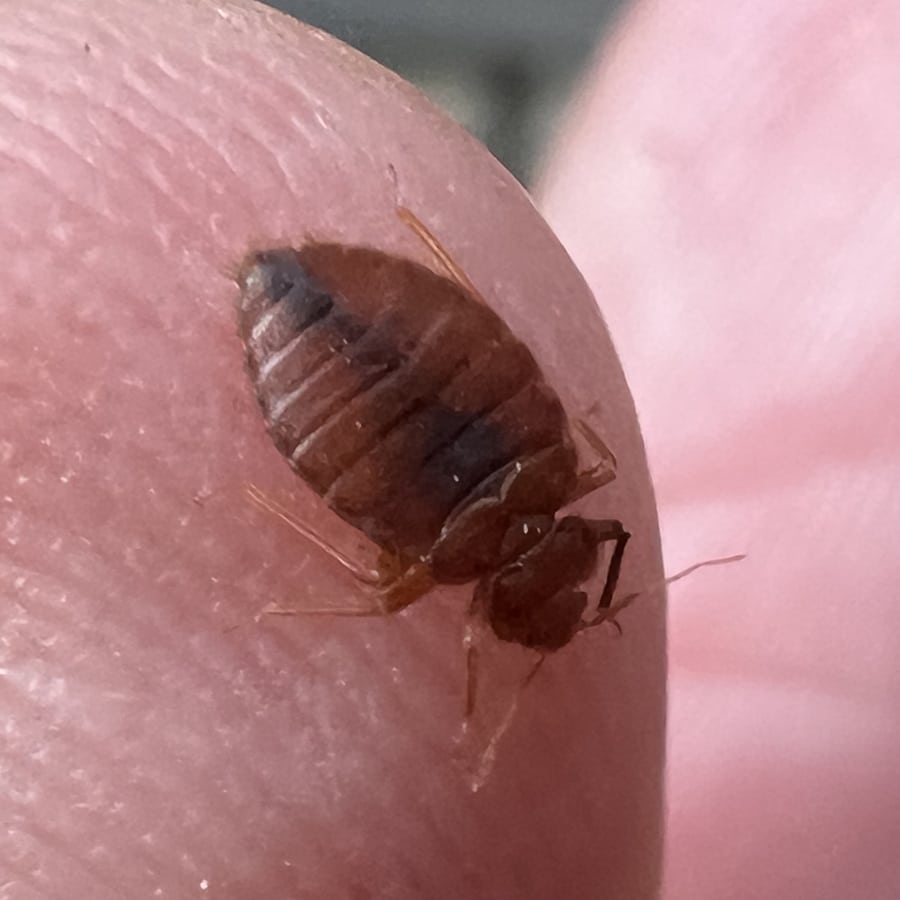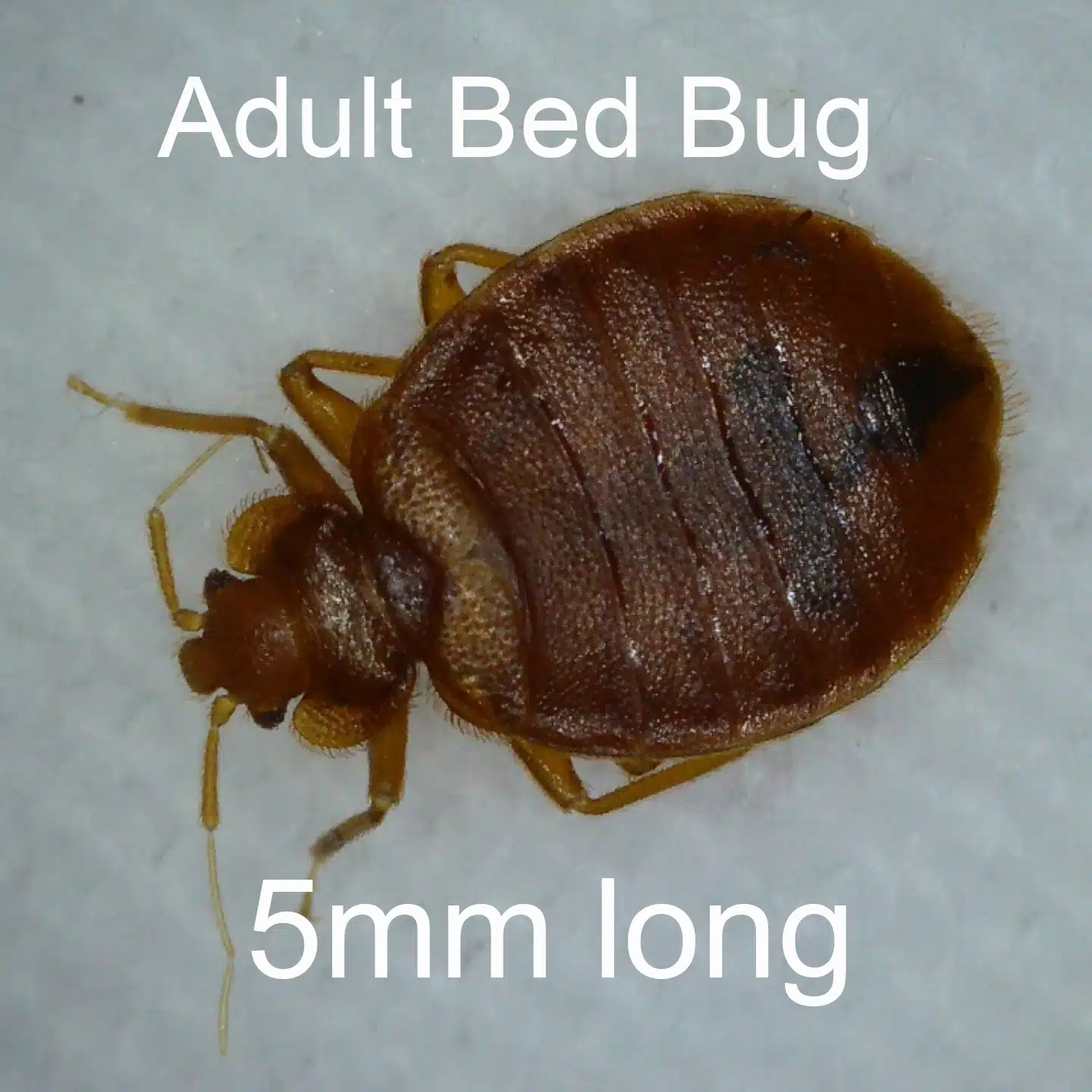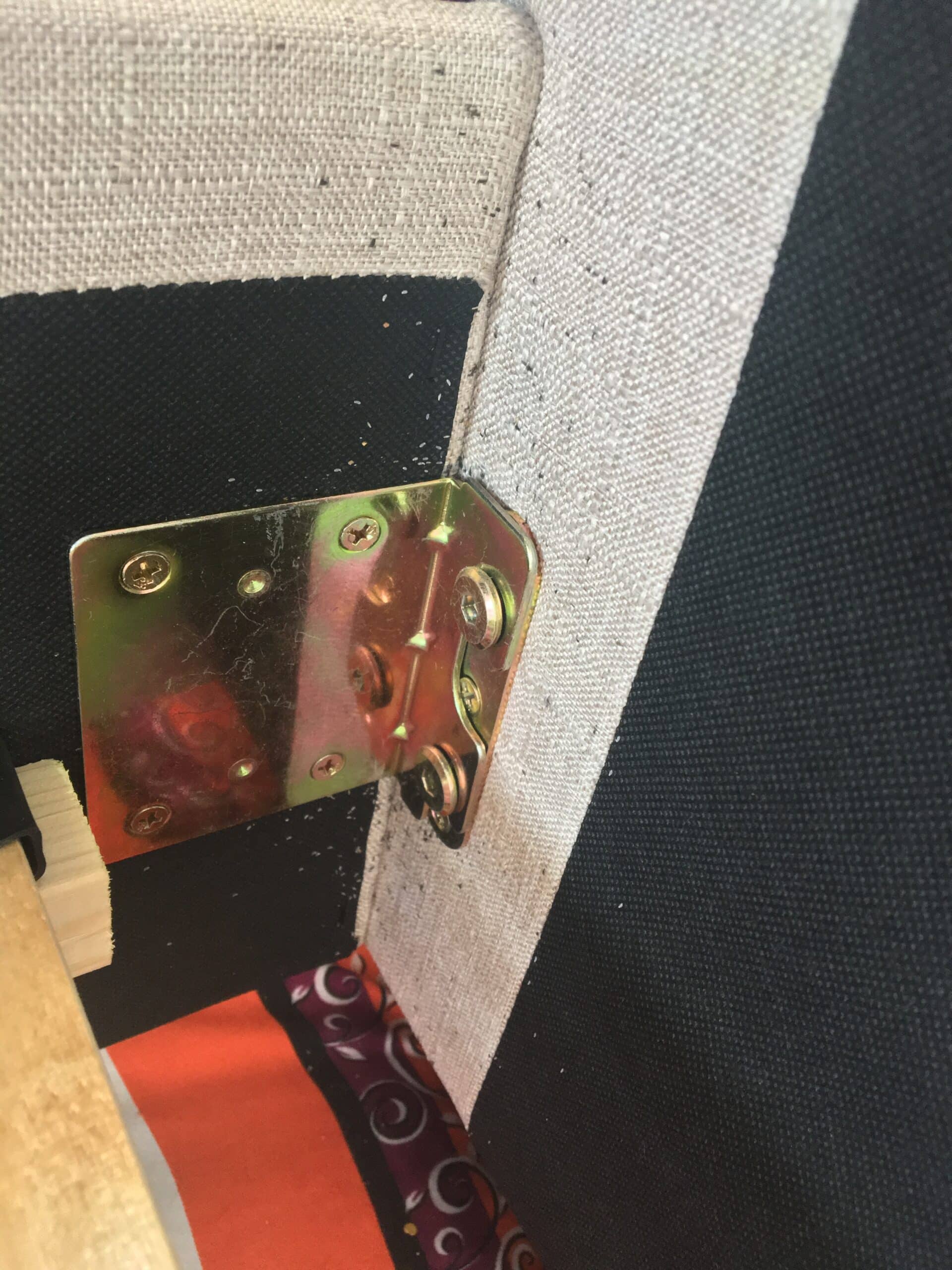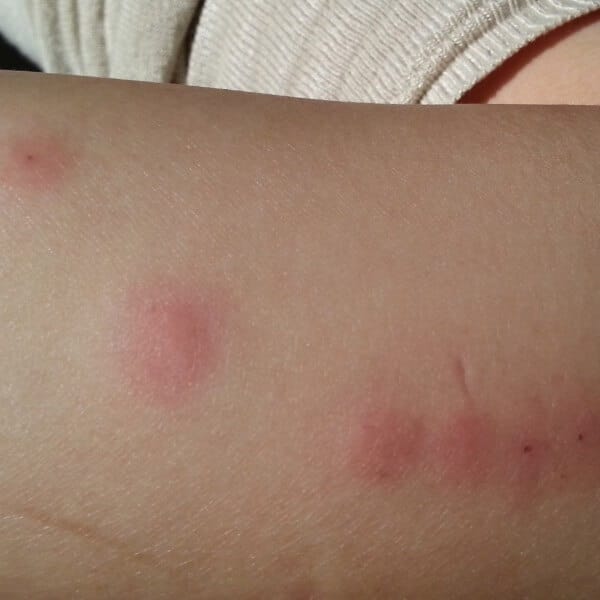
In the article
If you wake up with bites and you think you have bed bugs, the first question you might ask yourself is “What do bed bugs look like?”
Bed bugs are tiny, flat, oval-shaped insects with six legs and two antennae. Their appearance changes depending on their age and whether they’ve had a meal. Hungry adult bed bugs are usually a medium dark brown, but after a blood meal, they turn a darker red-brown.
You can see adult bed bugs without a magnifying glass—they’re about the size of an apple seed (5mm). If they haven’t eaten, they’re flat, but after feeding, they become redder, swollen, and longer.
Baby bed bugs, or nymphs hatch from white, 1mm-long eggs. The first-stage instars (1mm) are translucent yellow until they feed, after which they change to a brown colour.
Bed Bugs Are Nocturnal Insects
Bed bugs are night owls, coming out to bite when you’re fast asleep. They zero in on the carbon dioxide you breathe out and the warmth of your body. Although they prefer the cover of darkness, they will snack on you during the day if your infestation grows and is left untreated.
Their bites can make you itch, cause allergic reactions, and mess with your peace of mind, making their nighttime antics a real pain.

Where Do Bed Bugs Hide?
Sneaky spots include:
- Mattress and ensemble bases in seams, piping, and tags
- Cracks in bed frames
- Behind wallpaper
- Inside electrical outlets and light fittings
- Behind baseboards
- In your clothes and luggage
- Behind picture frames
- Among your clutter
- Carpets
- Walls
- Upholstered furniture

Tiny White Bed Bug Eggs
Thanks to their tiny, flat bodies, bed bugs can squeeze into the tightest spots, making them tough to find and get rid of. For more tips on tracking these pests, check out our guide on how to check for bed bugs.
Knowing how bed bugs behave and where they like to hide can help you catch an infestation early. For more on spotting the first signs of these pests, see our article on early signs of bed bugs.
Signs of Bed Bug Infestation
Spotting bed bugs early can save you a lot of headaches. Here’s how to tell if these pesky critters have moved in.
Bites and Skin Reactions
Bed bug bites can be tricky. They might look like bites from other bugs, or even rashes or hives. Some folks don’t react at all. But if you do get bitten, you’ll usually see bites in lines, clusters, or a zigzag pattern. They’re super itchy and often show up on your face, neck, arms, and hands—places that are exposed while you sleep.

Bed Bug Bites
Physical Evidence of Bed Bugs
The best way to know if you’ve got bed bugs is to look for physical signs. Here’s what to watch for:
- Excrement: Tiny black spots on mattresses, couches, and other furniture.
- Shed Skins and Eggshells: Found in mattress seams, crevices, and furniture joints. These are a sure sign of an active infestation.
- Eggs: Tiny, white, and usually in clusters. Bloodstains on sheets and shed skins are also big red flags.
- Characteristic Smell: Bed bugs give off a smell like sweet moldy gym socks or rotting raspberries. Dogs trained to sniff out bed bugs can confirm infestations.
- Fecal Spots: Small reddish-brown spots on mattresses, upholstery, or walls.
- Live Bed Bugs: Bed bugs are smal, flat, oval-shaped insects. Adult bed bugs are a medium dark brown, but after a blood meal, they turn a darker red-brown.
- Bed Bug Bites: red, itch raised bumps in a line, zig-zag, or cluster pattern.
Effective Bed Bug Control Methods
If bed bugs do invade, you’ll need to act fast. Here are some ways to get rid of them:
- Heat Treatment: Use a bed bug steamer to kill bed bugs and their eggs with steam. This method is chemical-free and can reach deep into fabrics and tiny crevices.
- Diatomaceous Earth: This natural powder is safe and effective. It damages the bed bugs’ exoskeletons, causing them to dehydrate and die.
- Mattress Covers: Use protective covers on your mattress and box spring to trap any bed bugs inside and keep new ones out.
- Barriers and Tape: Place barriers or tape around bed legs and other entry points to stop bed bugs from climbing onto your furniture.
By following these tips and methods, you can keep bed bugs away and deal with them effectively if they do show up. For more info on spotting and handling bed bugs, check out our articles on early signs of bed bugs and can you see bed bugs.
How to Get Rid of Bed Bugs On A Bed Frame
If you think you have bed bugs, don’t panic, we have the perfect bed bug treatment for you.
Follow these 3 easy steps to get rid of them fast and forever.
DIY Treatment For A Bed Frame
Step 1: Secure the Mattress
Cover your sleeping mattress with a mattress cover. This will trap and kill by starving them.
Step 2: Treat the bed frame
Use a Steamer to steam the entire bed frame to kill them instantly.
Dust the entire bed frame with Diatomaceous Earth (Killer Powder) using a powder duster.
Step 3: Set Up Barriers or Tape
To protect yourself from bed bugs in the room, use our barriers:
Floor Barriers:
Place bed legs in the Floor Barrier, dusting powder inside the tray and barrier.
Barrier Tape:
For bed legs larger than 65mm, use our barrier tape and dust the powder around the bed leg and floor.
Keep your bed at least 30cm away from walls and other furniture.
How To Get Rid Of Bed Bugs On An Ensemble Bed
Step 1: Secure the Mattress
Cover your sleeping mattress with a mattress cover. This will trap and kill by starving them.
Step 2: Treat the Ensemble Base
Stand the base on its end, remove the wheels, and cover it with an ensemble base cover. Screw the wheels back into the base.
Step 3: Set Up Barriers
To protect yourself from bed bugs in the room, use bed bug barriers:
Screw-in Barriers: Attach the Screw in Barriers to the legs of the ensemble beds. Apply Kiler powder inside and outside the barriers and on the wheels.
Floor Barriers: Place bed legs in the Floor Barrier, dusting Killer powder inside the tray and barrier.
Keep your bed at least 30cm away from walls and other furniture.
Bed Bug Prevention Tips
1. Always Check Hotel Beds When Traveling. When you stay at a hotel, always look at the mattress and bedding. Look for tiny blood spots, dark poop stains, or little bugs.
2. When You Return From Traveling: When you get home, wash all your clothes in hot water and clean your luggage. If you can’t wash something, put it in a plastic bag and freeze it for four days to kill any bugs.
3. Avoid Second-Hand Furniture or Mattresses: Don’t bring old furniture or mattresses into your home. They might have bedbugs.
4.Use Diatomaceous Earth (DE): Put DE around power points and electrical outlets to stop bed bugs from getting in from other places.
5. Apply DE to Your Bed Frame: Putting DE on your bed frame is a great way to stop bedbugs because it keeps working until you clean it off.
6. Guests: If you have guests who have been traveling, wash their clothes in hot water and clean their luggage. They might accidentally bring bedbugs into your home.
7. New Housemates: If you have new housemates who stayed in backpacker hostels, wash their clothes in hot water and clean their luggage to keep bedbugs out.
Following these steps will ensure they are effectively eliminated from your bed and room, allowing you to sleep peacefully, knowing you’re protected. To find out more about our products check out our bed bug product page.
Frequently Asked Questions:
- How can I tell if we have bed bugs?
Look for small, reddish-brown bugs about the size of an apple seed, dark spots (excrement), shed skins, and tiny white eggs around your mattress and furniture. You might also see red, itchy bites on your skin in a line or cluster. - What does a bed bug look like to the human eye?
Adult bed bugs are flat, oval-shaped, and about the size of an apple seed. They’re medium dark brown when hungry and redder and swollen after feeding. Baby bed bugs are translucent yellow at first and turn brown after feeding. - What is the main cause of bed bugs?
Bed bug infestations are often caused by travel and secondhand furniture. They hitch rides on luggage, clothing, and used furniture, quickly spreading once they find a suitable environment.
Sources:
Pestworld (bed bug), Terminix (Where do bed bugs come from?) EPA (How to find bed bugs)



Leave a Reply